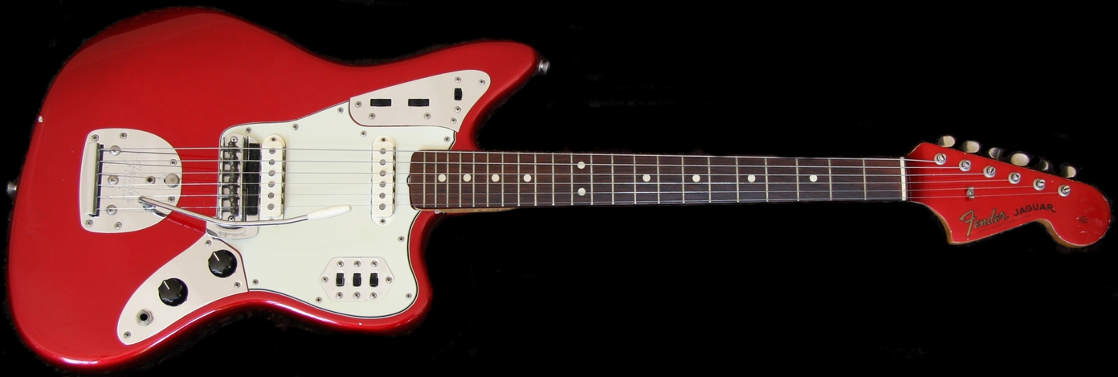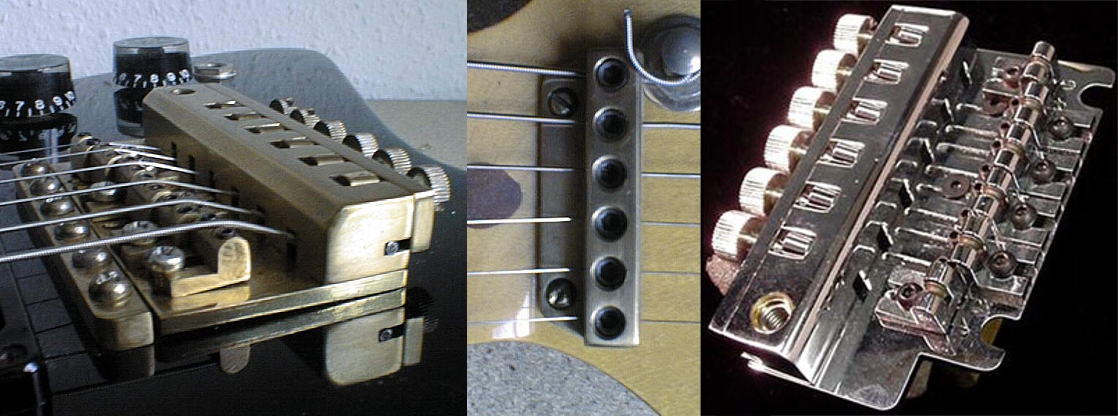 About Jaguars in general:
About Jaguars in general:
If I had to pick a word to describe the Fender Jaguar, it would be "Groovy". Not meaning that I think they are good guitars, actually far from it, more like groovy as in "Whatever". They do look cool, and all the controls were neat, for the time they were made, but they are a design disaster, and most of the following holds true for Jazzmasters as well, and parts of it also applies to Mustangs. Here is one from 1964 in extraordinary shape, with a headstock to match the body, which is not the standard, most of them were finished clear like the rest of the neck.

What were the people at fender thinking? Strat's already had the best tremolo ever made at the time, and that held true up until the German improvement thereof, the "Rockinger" tremolo came out. Rockinger's were around two years prior to, and nearly identical to a Floyd Rose, complete with fine tuners and locking nut, but without string locks on the bridge. Floyd Rose's true claim to fame was improving the design, but his first batch of bridges were near impossible to get tuned up because they had no fine tuners, and you had to spend a large amount of time locking, tuning, re-locking and re-tuning to finally have it right!
Below is a 1979 Rockinger, the Rockinger locking nut (Prone to string breakage), and the 1980 Rockinger with pivot post design (Posts not shown). For those who think it was Floyd Rose's invention, as history falsely recalls it.

Anyhow, with the Jaguar and Jazzmaster Fender tried to reinvent the wheel, as the tremolos are way over complicated, have 3 times as many parts as the Strat trem's, and do not stay in tune for longer than one minute, and that's in the "locked" position! Using threaded rods as saddles does not allow for even string spacing, and although some featured barrel saddles like all Mustangs, they were not replaced as a whole at any given time, but some just had threads, and others barrels, seemingly with no rhyme or reason. The fact that they were not made for very long may have something (possibly everything) to do with it.
OK, so it was not designed for dive bombing, but the silly pivoting bridge that can only pivot a mere millimeter in either direction, and does not always return to center despite the centering plug on a spring. The enormous length of string between the bridge and tremolo unit added to the equally large distance between the nut and tuners, is more than enough to insure tuning problems. Although the trem-arm spring can be adjusted (with the unit off of the guitar), the difference between it's tightest and loosest settings is small, and they feal flimsy either way, and have very little travel. Besides the same bad bridge tilting design, the Mustang has a better tremolo system, but still not as good as a Strat.
If the tremolo was not bad enough, having no neck angle and bridge height puts so little string pressure on the bridge, that sustain is nearly non existent, and the lack of string break angle from the nut to the tuners robs it of some more and promotes string buzz with less than 10 windings on the tuners, and giving it even more reason not to stay in tune.
Finally the ingenious magnetic focus brackets on the pickups are actually a good idea for the time! To bad no one showed the employees, which way around they are supposed to be installed! Thousands of instruments left the factory with one or both installed wrong. They were made to shield more magnetic waves under the wound strings, which back then included the G string, so that the B and High E strings could stand out a bit more. That is why the shielding bracket segments are 4 of one height and two of another, see what I mean:

Here you are looking from the bridge end, and the bracket is installed right for the bridge pickup, but wrong for the neck pickup. This picture is from another Jaguar I had in. On this one they were both wrong, but I did not take as many pictures as I should have, which happens because I concentrate on my work enough to forget to take pictures. If you have a jaguar laying around, check it out, the brackets could be any which way.
One last thing before I get to work on this thing: Fender has reissued the Jaguar in varying configurations more recently, but from what I can tell no improvements have been made in the string path. There is although the "Johnny Marr" version that has nylon sleeves around the bridge posts to prevent it from tilting and getting stuck in position, but Fender should have changed the bridge posts to not tilt on all of them, and added roller saddles, since the original design does not work. I have made sleeves for many Jaguars, Jazzmaster's and Mustangs over the years, and I am surely not the only one. The pickup shields still have two lower, and four higher tongues on each side, but since G strings have not been wound since shortly after the Jag' came out in 1962, there should be 3 high and 3 short ones, and in all reality they should all have slightly different heights from each other, to truly work as intended.
In essence the new Jaguars are just as bad as the old ones, and for the most part not used as serious instruments by discerning players, but rather by artists who put more value in their retro appeal, and collectors counting on their future value. I can not state often enough how much I detest the guitar collectors market for inflating crap over quality, and mass production over one of a kind's. The whole essence of collecting is based on rarity, not hoarding.
 Jaguars need more than a setup:
Jaguars need more than a setup:
When I got an email asking for an appointment to setup a Fender Jaguar, I had to reply with a few questions: Was it ever setup good? Did it ever hold intonation? Has it always lacked sustain? Are you afraid to tough the whammy bar in fear of throwing the whole thing off? I got the expected answer code: No, No, Yes, Yes. I then followed up with the make or break questions: Are you a serious collector, or a serious player, and if both which means more to you? Are you more interested in a good playing and sounding guitar, or do you want to keep it factory original? He replied that he would rather play it than hang it on the wall, which is all I had to hear to gladly give him an appointment. Not that I would not have otherwise, but had he opted for factory original, I would have warned him that my efforts were of little use, could not be guaranteed, and still cost him money.
All too often do people believe that a setup is all that is needed, to make a guitar do what a guitar is supposed to do. The problem with that, as in this case is that it depends on weather the guitar was made the way a guitar should be made, for it to do what it is supposed to do, in the best possible way. The biggest problem I can see in the guitar industry is that almost everyone is doing what everyone else is, rather than improving on what others are doing. Most of all, unlike in most other industries, few seem to make real improvements, over seeming improvements, and there is more snake oil in guitars than in pharmaceuticals these days.
I explained to him what needed to be done to make his Jaguar a player, rather than a wall hanger, and that it would cost more than a mere setup, but also that it was a one time expense, as subsequent setups will be effective moving forward. As stated earlier, I do like the groovy looks and electronics of Jaguars, but with the most important features missing, being playability and stability good looks are worthless. So should you have a Jaguar, Jazzmaster or Mustang, and are unsatisfied with the performance, you know who to contact.